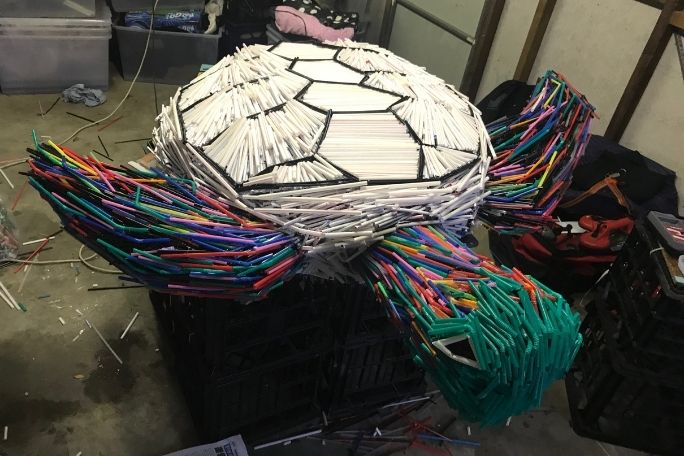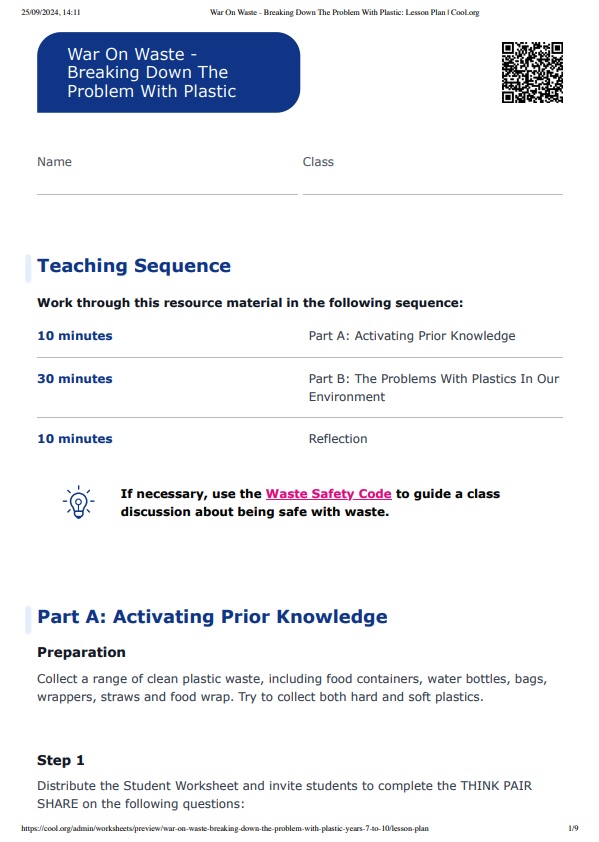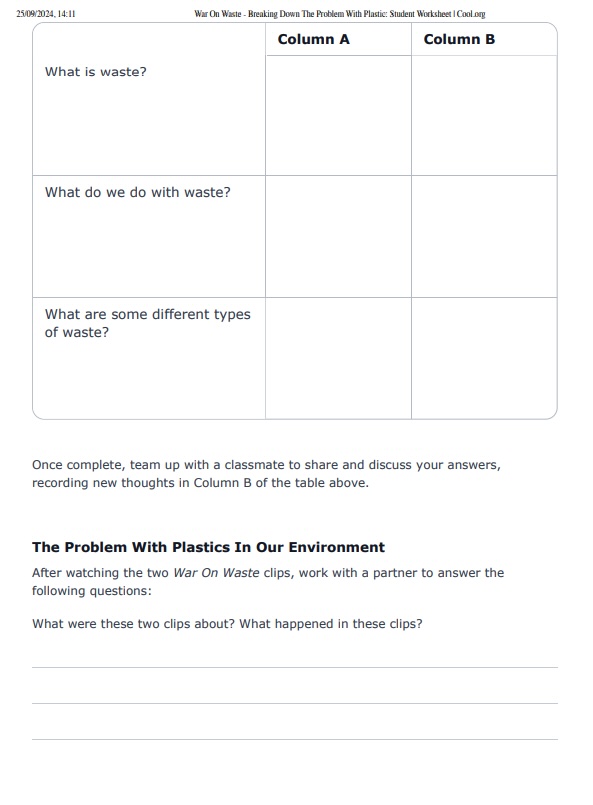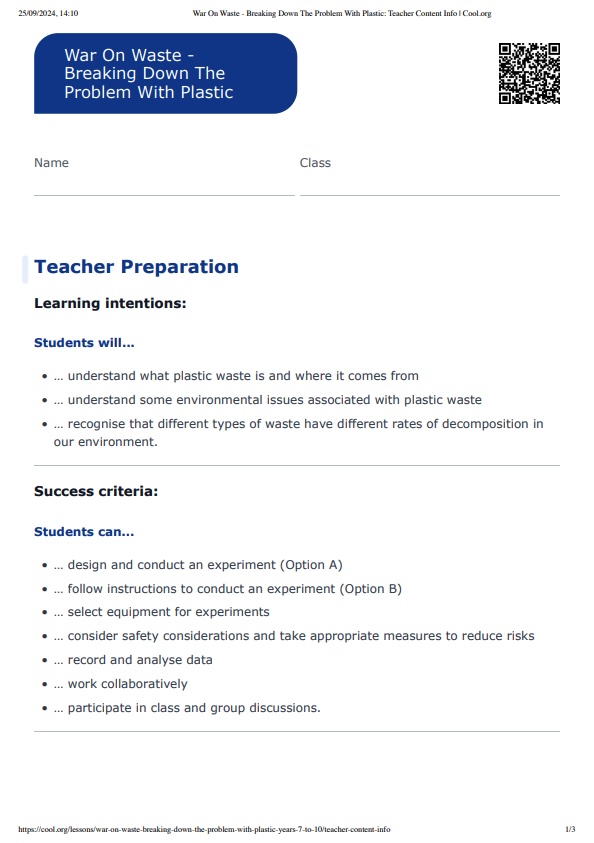Lesson summary
In this lesson, students explore the impacts of plastic waste on our environment. They begin by sharing what they already know about plastic waste before exploring some of the impacts of plastic waste on our environment. Using the instructions provided, they then design and/or conduct an experiment to test the decomposition rates of hard and soft plastics. Students can use the results of this experiment to drive action in the follow-up social action lesson.
Learning intentions:
Students will...
- understand what plastic waste is and where it comes from
- understand some environmental issues associated with plastic waste
- recognise that different types of waste have different rates of decomposition in our environment.
Success criteria:
Students can...
- design and conduct an experiment (Option A)
- follow instructions to conduct an experiment (Option B)
- select equipment for experiments
- consider safety considerations and take appropriate measures to reduce risks
- record and analyse data
- work collaboratively
- participate in class and group discussions.
Lesson guides and printables
Curriculum links
Select your curriculum from the options below.
Lesson details
Curriculum Mapping
Australian curriculum content descriptions:
Year 7 Science:
- Some of Earth’s resources are renewable, including water that cycles through the environment, but others are non-renewable (ACSSU116)
- Collaboratively and individually plan and conduct a range of investigation types, including fieldwork and experiments, ensuring safety and ethical guidelines are followed (ACSIS125)
- Measure and control variables, select equipment appropriate to the task and collect data with accuracy (ACSIS126)
- Construct and use a range of representations, including graphs, keys and models to represent and analyse patterns or relationships in data using digital technologies as appropriate (ACSIS129)
- Summarise data, from students’ own investigations and secondary sources, and use scientific understanding to identify relationships and draw conclusions based on evidence (ACSIS130)
- Reflect on scientific investigations including evaluating the quality of the data collected, and identifying improvements (ACSIS131)
Year 8 Science:
- Collaboratively and individually plan and conduct a range of investigation types, including fieldwork and experiments, ensuring safety and ethical guidelines are followed (ACSIS140)
- Measure and control variables, select equipment appropriate to the task and collect data with accuracy (ACSIS141)
- Construct and use a range of representations, including graphs, keys and models to represent and analyse patterns or relationships in data using digital technologies as appropriate (ACSIS144)
- Summarise data, from students’ own investigations and secondary sources, and use scientific understanding to identify relationships and draw conclusions based on evidence (ACSIS145)
- Reflect on scientific investigations including evaluating the quality of the data collected, and identifying improvements (ACSIS146)
Year 9 Science:
- Plan, select and use appropriate investigation types, including field work and laboratory experimentation, to collect reliable data; assess risk and address ethical issues associated with these methods (ACSIS165)
- Select and use appropriate equipment, including digital technologies, to collect and record data systematically and accurately (ACSIS166)
- Use knowledge of scientific concepts to draw conclusions that are consistent with evidence (ACSIS170)
- Evaluate conclusions, including identifying sources of uncertainty and possible alternative explanations, and describe specific ways to improve the quality of the data (ACSIS171)
- Communicate scientific ideas and information for a particular purpose, including constructing evidence-based arguments and using appropriate scientific language, conventions and representations (ACSIS174)
Year 10 Science:
- Plan, select and use appropriate investigation types, including field work and laboratory experimentation, to collect reliable data; assess risk and address ethical issues associated with these methods (ACSIS199)
- Select and use appropriate equipment, including digital technologies, to collect and record data systematically and accurately (ACSIS200)
- Use knowledge of scientific concepts to draw conclusions that are consistent with evidence (ACSIS204)
- Evaluate conclusions, including identifying sources of uncertainty and possible alternative explanations, and describe specific ways to improve the quality of the data (ACSIS205)
- Communicate scientific ideas and information for a particular purpose, including constructing evidence-based arguments and using appropriate scientific language, conventions and representations (ACSIS208)
Syllabus outcomes: SC4-12ES, SC4-5WS, SC4-6WS, SC4-7WS, SC5-5WS, SC5-6WS, SC5-7WS, SC5-9WS.
General capabilities: Critical and Creative Thinking
Cross-curriculum priority: Sustainability OI.7, OI.8, OI.9
Relevant parts of Year 7 Science achievement standards: Students plan fair experimental methods, identifying variables to be changed and measured. They select equipment that improves fairness and accuracy and describe how they considered safety. Students draw on evidence to support their conclusions. They summarise data and refer to the quality of their data when suggesting improvements to their methods. They communicate their ideas, methods and findings using scientific language and appropriate representations.
Relevant parts of Year 8 Science achievement standards: Students consider safety when planning investigations, including designing field or experimental methods. They identify variables to be changed, measured and controlled. Students construct representations of their data to reveal and analyse patterns and trends, and use these when justifying their conclusions. They explain how modifications to methods could improve the quality of their data and apply their own scientific knowledge and investigation findings to evaluate claims made by others. They use appropriate language and representations to communicate science ideas, methods and findings in a range of text types.
Relevant parts of Year 9 Science achievement standards: Student design methods that include the control and accurate measurement of variables and systematic collection of data and describe how they considered safety. They analyse trends in data, and analyse their methods and the quality of their data, and explain specific actions to improve the quality of their evidence. They use appropriate language and representations when communicating their findings and ideas to specific audiences.
Relevant parts of Year 10 Science achievement standards: Students independently design and improve appropriate methods of investigation, including field work and laboratory experimentation. They explain how they have considered reliability and safety actions in their methods. When analysing data, selecting evidence and developing and justifying conclusions, they identify alternative explanations for findings and explain any sources of uncertainty. They construct evidence-based arguments and select appropriate representations and text types to communicate science ideas for specific purposes.
Unit of work: War On Waste – Years 7-10
Time required: 110+ mins (depending on the option chosen, you will need time to design and set up the experiment, and then check in with waste items every few weeks to check decomposition rates)
Resources Required
- Device with internet and presenting capability
- Option A: Design your own experiment
- Option B: Conduct a waste breakdown experiment
- Plastic Pollution Factsheet
- Student Worksheet – one copy per student
- Waste Safety Code (optional)
- For the classroom demonstration:
- Collect a range of clean plastic waste, including food containers, water bottles, bags, wrappers, straws and food wrap. Try to collect both hard and soft plastics.
- For the experiment:
- A variety of household waste items, including both soft and hard plastic. In addition, you could also test other types of packaging such as metal containers, and paper or cardboard packaging. You will need three of each item.
- Short wooden or metal stakes
- Buckets
- Water
- Soil (or somewhere to dig a hole and bury waste items)
- Shovel
- Mallet
- Labels
- Camera
- Gloves
Skills
This lesson is designed to build students’ competencies in the following skills:
- collaboration
- communication
- creativity
- critical thinking
Additional Info
Cool Australia’s War On Waste lessons have been developed in partnership with Lune Media and with support from the Australian Environmental Grantmakers Network. These lessons have been designed to lead students through a deeper understanding of some of the big issues relating to waste in Australia and to support them to take action to reduce the impact of waste on our environment.




Welcome back!
Don't have an account yet?
Log in with:
Create your free Cool.org account.
Many of our resources are free, with an option to upgrade to Cool+ for premium content.
Already have an account?
Sign up with:
By signing up you accept Cool.org's Terms and Conditions(Opens in new tab) and Privacy Policy(Opens in new tab).